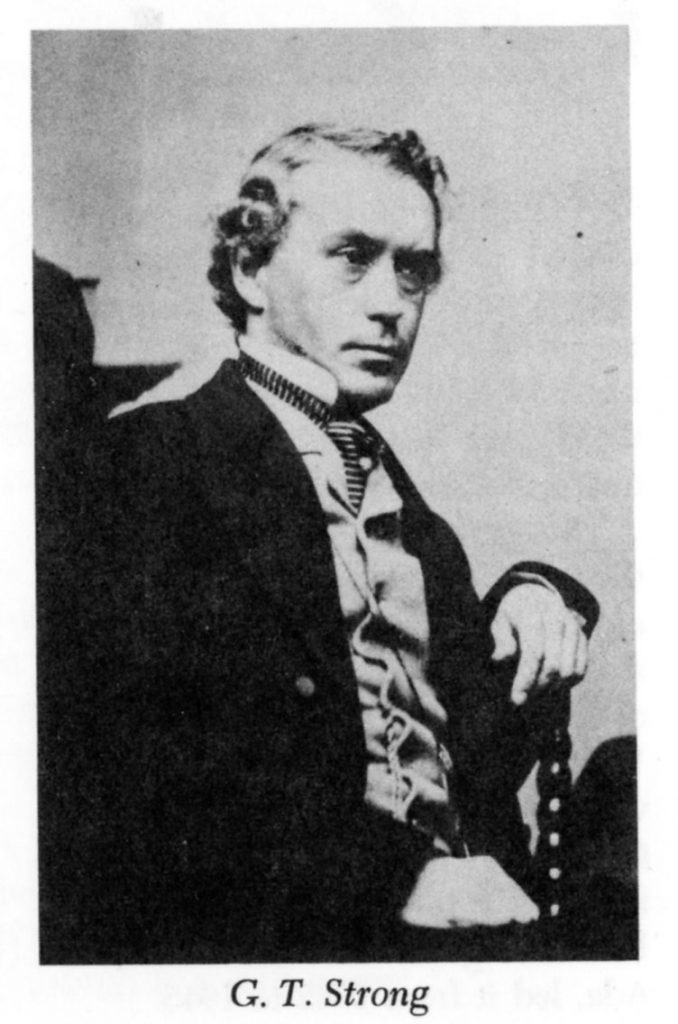To understand life in seventeenth century London, the diary of Samuel Pepys is required reading. Diarists of his caliber are rare finds for the historian; but when they are uncovered, other sources of material do not compare for the recoding of events and the flavor of life in the period.
In 1952, the distinguished Columbia University historian Allen Nevins and his colleague Milton H. Thomas published a four-volume edited version of the diary of George Templeton Strong. The original Strong papers, which run to nearly four and one half million words neatly written in blank notebooks and undiscovered by scholars for more than forty years after his death, provide an amazing look at life in New York from 1835 to 1875.
Since strong was a St. Luke’s trustee from 1852 to 1857, his entries abound with references to the hospital, to Dr. Muhlenberg, to Robert B. Minturn the first St. Luke’s president, and to many others associated with St. Luke’s and its beginnings. The diary provides particularly interesting reading for those who are now associate with St. Luke’s.
From his days as a Columbia student through a long career as a leading attorney, Strong faithfully recorded the period’s events, leaving an unparalleled record of observations about the great and small happenings in each day of these forty hectic years. The diary became public when a history of Strong’s firm, now known as Cadwalader, Wickersham and Taft, was being written in the 1930’s, and later was given to Columbia University.

Volume III, which deals with the Civil War period, is the best known book in the series and is listed in the bibliography of most books written on the period. Strong served as a member of the pioneering Sanitary Commission, which provided the medical care and supplementary serviced needed by the Union army and the civilian population. In this voluntary capacity, he was on intimate terms with government leaders and with all of the principal military figures.
The diarist was a Columbia University trustee, and notes that he learned of his election to that body while attending a St. Luke’s meeting. His principle interest during his long association with his alma mater, were the School of Law and of Mines. He also points out his consternation about being named to the fund raising committee of the St. Luke’s board. A difficult task was his assignment by Muhlenberg to develop a motto for the hospital. Unfortunately, the diary does not indicate whether he finally did suggest “Corpus Sanare, Animan Salvare,” the motto found on the St. Luke’s seal. Ample references are found to the numerous technical and legal difficulties the St. Luke’s founders encountered and to the differences of opinion reflected by the various early trustees. His family physician was Dr. George A. Peters, for eight years a president of the St. Luke’s medical Board.
Because he was not writing for publication, Strong was free to open his mind to the diary and his views of people and events are not limited by worry over injuring anyone’s feelings. Never has the phrase, ‘one man’s opinion’ been more apropos.
Born to an old and patrician family, Strong, whose grandfather sailed with Robert Fulton on the “Clermont” on the world’s first steamboat ride on the Hudson, was on intimate terms with most of the rich and powerful men of the age. Lincoln was his close friend, as were John Jacob Astor, Peter Cooper, Washington Irving and future President Chester A. Arthur. His funeral in 1875 was attended by President Ulysses S. Grant; Astor was among the pallbearers.
A brilliant writer with a gifted pen and a reporter’s sense for detail, his notes on the minutia of family life and his descriptions of fires, trails, riots and people all form a clear and complete picture of the City he knew and loved. His detailed observations of the music and literature of the period and his analysis of sermons preached at Trinity Church, where he was a vestryman, show his broad grasp of subjects and his keep sense of the pertinent.
For those interested in the development of New York, its institutions and the people who turned it from a compact, if lively, port in 1835 to the bustling metropolis it was by 1875, the diary of St. Luke’s trustee George Templeton Strong is an invaluable source of information.
This article was first published in June 1970 issue of The News of St. Luke’s Hospital Center, from the archival collection of St. Luke’s Hospital Center. https://archives.mssm.edu/aa098-s004-ss002-ss003
Copies of the diaries have been digitized and are found here: https://digitalcollections.nyhistory.org/islandora/object/nyhs%3Astrong
